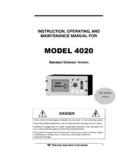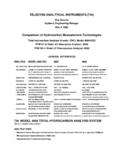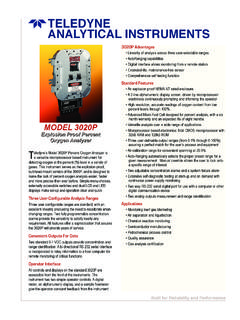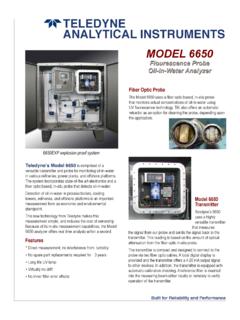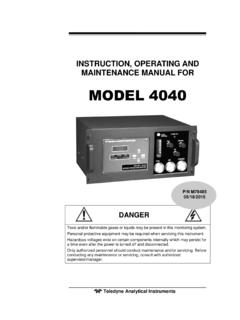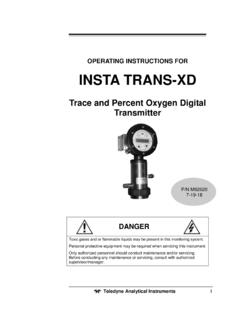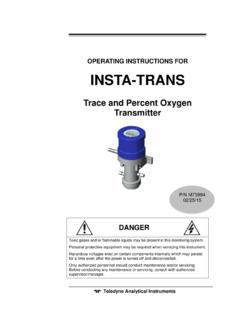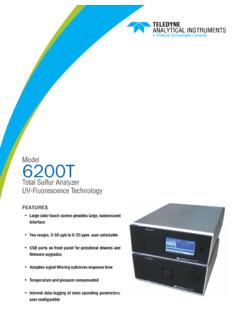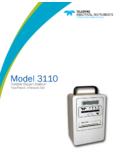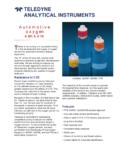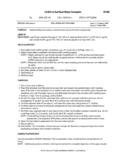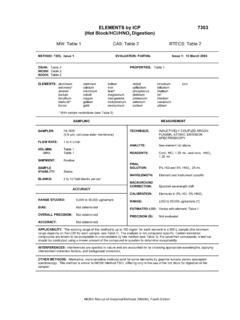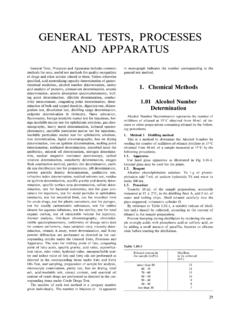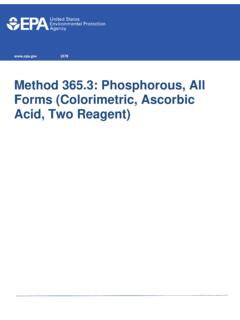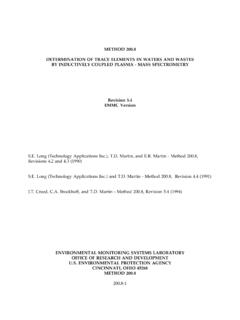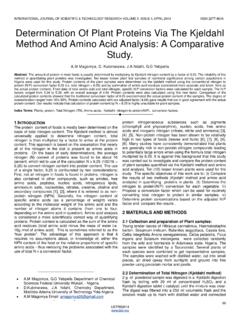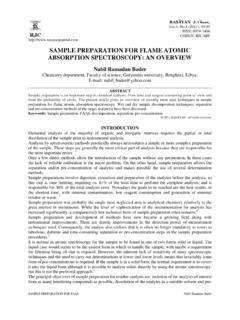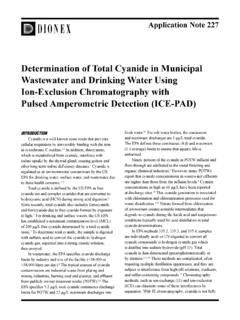Transcription of Total Organic Carbon On line Analysis of Organic in …
1 Total Organic CarbonTeledyne Analytical InstrumentsOn line Analysis of Organic in WaterFor years TOC Analysis has been reserved for specialists. Now it is more frequently used for water quality line chemical Analysis has been developed significantly thanks to digital electronics use of microprocessors together with the application of sophisticated and accurate analytical result of this combination is readily available technology which allows for on line performance of almost any analytical determination for quality control which is normally made in a laboratory. Moreover it allows for the automation of traditional chemical analyses generally considered difficult to do if not done monitoring can only be obtained utilizing sophisticated and modular instrumentation (with capacities of auto-diagnostics, auto-calibration, alarms) which can be easily and efficaciously maintained and is important not to forget the collateral aspects of Analysis , proper sampling and preconditioning of the sample as well as proper data collection.
2 It is also important that technicians are available for maintenance and control of the operation of the analytic in waterIn water analyzed for environmental purposes such as industrial, civil, surface (rivers, lakes, seas) waters, some important substances can be verified; namely nutritious matter or are: Organic substances, nitrogen compounds (ammonia, nitrates, nitrites) and phosphor ( Total phosphor or orthophosphate). These substances are called nutrients because they promote the growth and development of several types of microorganisms present in waste water treatment plants, nutrients are fundamental because they assure the greatest growth of microorganisms and consequently the best aerobic and anaerobic ideal amount of nutrients in waste waters is normally considered to be the ratio ofcarbon: nitrogen: phosphor = 100:5 lack of nutrients in waste water , particularly in industrial waters, together with other factors (pH, low dissolved oxygen levels) may promote the growth of undesirable microorganisms which cause plant inefficiency (thready microorganism growth - sphaerotilus, leptotrix, beggiatoa; mold which causes sludge explosion).
3 The presence of nutrients in surface waters also causes algae growth which diminishes dissolved oxygen. The river therefore becomes poor in oxygen and consequently in animal control is becoming more fundamental to treatment plants ability to manage and limit materialThe Total amount of Organic matter in water is called the Organic load and by definition consists of chemical compounds containing Carbon atoms (aliphatic and aromatic hydrocarbons and all of their derivatives, solvents included).Inorganic compounds which contain Carbon atoms are not part of Organic load; for example Carbon dioxide (CO2) dissolved in water produces carbonic acid (H2CO3) and its salts which are widespread in nature (sodium, calcium and iron salts).Other chemicals that are not part of the Organic load are: monoxide (CO), bisulfide (CS), Carbon tetrachlofigure ride (CCl4), cyanide, thiocyanate, carbide and pure, amorphous and crystalline line Analysis of Organic in WaterEasy to use programming and access to the various phases of Analysis make maintenance and management of the 6700 TOC analyzer Organic CarbonTeledyne Analytical InstrumentsOrganic compounds are biodegradable; that is they are used as food by various types of microorganisms such as bacteria and molds.
4 These microorganisms digest Organic matter and transform it into Carbon dioxide and other simpler doing so they produce substances necessary to their growth and energy for vital processes. This digestion process is called decay or putrefaction and it occurs along with dissolved oxygen consumption. Dissolved oxygen concentration decreases and the water becomes putrid. No oxygen remains until the biologic matter collapses. Organic matter is naturally present in surface water (fresh and sea water ).Its presence may also be due to intentional spilling by industries or communities (industrial or civil discharges), accidental spilling (cooling waters and condensates), or inefficiency of water purifying systems (ultrapure water for the electronic or pharmaceutical industries). Organic matter pollution is the most common type of water pollution.
5 The presence of Organic matter (which is not foreseen or accidental) is an indication of anomalies in of Analysis for OrganicsIn past years different types of analytical methods have been used for the determination of Organic best known methods are BOD, COD and TOC. Regulations and guidelines for these types of Analysis have been practical use other methods have been employed such as TOD ( Total Oxygen Demand), Kubel index (permanganate oxidability) and many other indirect of them are potentially valid, but too specific for particular uses with single applications. They are therefore not suitable for precise and reliable general common of the above-mentioned methods are: BOD (Biochemical Oxygen Demand) and COD (Chemical Oxygen Demand); these are both indirect methods based on oxygen consumption measurements made during the biologic oxidation reaction.
6 Oxygen consumption is relative to Organic matter between COD and TOCCOD Analysis has been used for decades and it is therefore considered official for all research, calculations and daily use with discharge management. For this reason it is necessary to constantly refer to the COD name is only related to the Analysis performed exactly following the official methods: - digestions for 2 hours at given conditions, and - with specified chemical, and determination of the reduced Cr VI to Cr III by colorimetry or Redox titration. Any other analytical methods performing an oxidation in a different form cannot be called properly problems are (assuming the Analysis is done correctly):- time necessary to perform this Analysis (approx. two hours),- interference which makes the test inaccurate,- restricted measurement ranges ( ranges lower than 20 ppm and higher than 1000 ppm are out of the question)- reagents which are considered dangerous and toxic (highly acid solutions containing mercury salts).
7 COD values are, at any rate, comparable to TOC values. With both methods Organic matter oxidizes according to the following equation:C + O2 CO2 One Carbon atom ( = 12) is combined with two oxygen atoms ( = 16) 32 grams of oxygen are used for 12 grams of should be COD/TOC = 32/12 = 2, value is theoretic and varies for Organic matter because hydrocarbons, which contain numerous hydrogen atoms, are able to combine with oxygen and thus produce water . These compounds require a greater quantity of oxygen, corresponding to a larger COD compounds have oxygen atoms which take part in the reaction thereby lowering the request for external oxygen. A general indication of the COD/TOC ratio is presumed to be around 3. Different values indicate a change in the Organic has been noted that the COD/TOC ratio in plant dis charge is well defined and repeatable, as long as the Organic matter type is :METHANE (CH4)CH4 + 2 O2 CO2 + 2 H2O2x32 /12 = 64 /12 = 5,333 BENZENE (C6H6)2 C6H6 + 15 O2 12 CO2 + 6 H2O15x32 /12x12 = 480 /144 = 3,333 METHANOL (CH3-OH)2 CH3OH + 3 O2 2 CO2 + 4 H2O3x32 /2x12 = 96 /24 = 4 ETHANOL (C2H5-OH)C2H5OH + 3 O2 2 CO2 + 3 H2O3x32 /2x12 = 96 /24 = 4 TOLUOL (C6H5-CH3)C6H5CH3 + 9 O2 7 CO2 + 4 H2O9x32 /7x12 = 288 /84 = 3,4292 Total Organic CarbonTeledyne Analytical InstrumentsIt is clear that this ratio can change depending on the oxidation state of the Organic matter.
8 It is obvious that Inlet water of a treatment plant has a COD/TOC ratio which is different from that of the outlet water (after treatment). Nevertheless each single ratio remains more or less the case COD on line Analysis is absolutely necessary, it would be possible to automate utilizing analytical robots belonging to the same category as those dedicated to nutrient analysisAll methods cited in previous paragraphs provide indications of Organic matter concentrations in relation to oxygen consumption. Those are indirect method. On the contrary, the analytical method which is employed for Organic Carbon Analysis , TOC, implies the direct determination of the amount of organics through measurement of Carbon in CO2 molecules generated during Organic matter method is as a result based on Organic matter oxidation followed by CO2 avoid possible interference, inorganic Carbon is removed by means of acidification and stripping.
9 Over the years and since 1962 when the first TOC analyzer was presented in the United States by Dow Chemical and Union Carbide, different types of analytical methods have been developed and relative instruments have been invented - both laboratory and on line ; all of these instruments were designed to employ available technology of the day to perform this institutes and standardization offices approved and documented official methods for TOC Analysis (Standard Methods 5310A, B, C; EPA and EPA ; APHA 505a e B; ISO 8245; DIN 38409H3; ASTM; UNICHIM 944).Between 1995 and 1997 the CEN/TC technical committees met to discuss water Analysis and water Quality . Those meeting was arranged by the European Committee for Analysis in water , after the evaluation by European experts of years of research and experience, was proposed for official approval as a guideline.
10 It was later recommended to all European countries and CEN members as an official Analysis for the purpose of water quality control. The draft have been approved in 1997 and become an European StandardDefinitionsDefinitions concerning Organic matter Analysis are varied, although efforts at normalization have been made, a unequivocal and universal definition does not yet examples of common abbreviations:TC = Total Carbon ;TIC = Total Inorganic Carbon ;IC = Inorganic Carbon ;TOC = Total Organic Carbon ;DOC = Dissolved Organic Carbon ;NPOC= Non Purging Organic Carbon ;NDOC= Non Dissolved Organic some cases Totally Organically bound Carbon is considered line TOC Analysis for water & pollution controlProcess TOC analyzers are assembled according to the official criteria mentioned s Model 6700 TOC analyzer, for example, is the result of extensive experience of several European and American companies.
